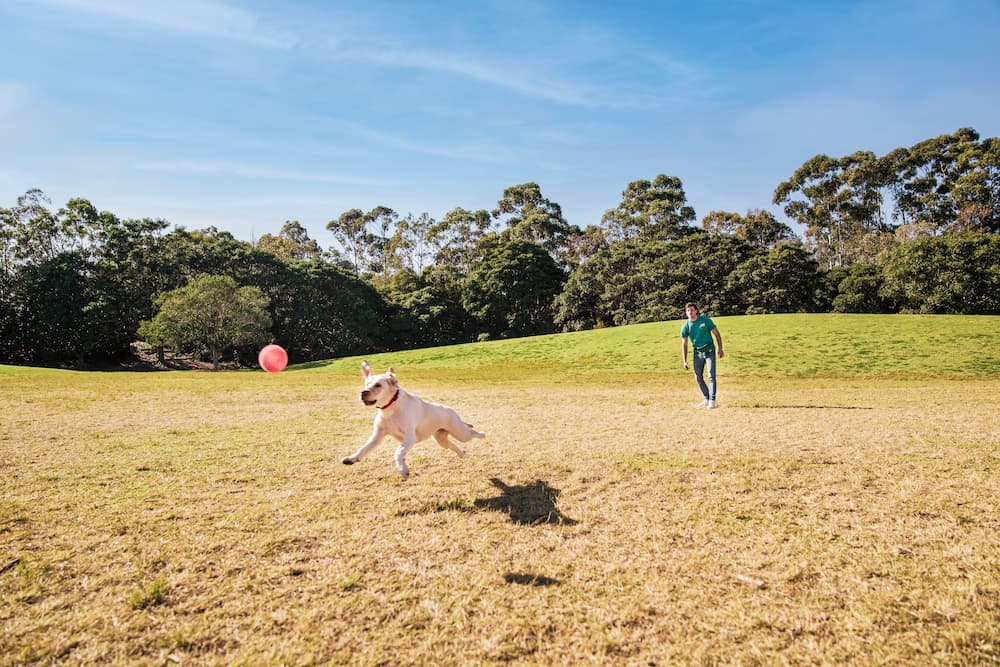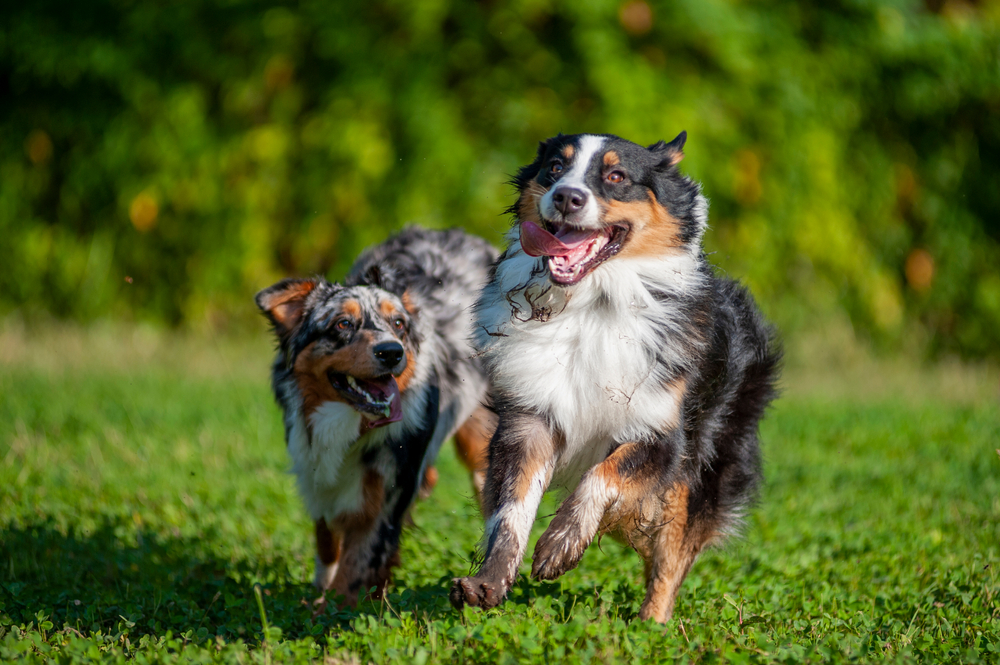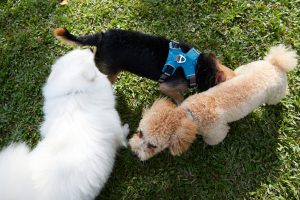Whether you’re new to owning a dog or a seasoned pooch pro, you might be curious about that fabled place so beloved by Dog Owners the world over: the almighty dog park. The dog park is a spot for doggos to interact with their peers and roam off-leash. It’s also a great place for Owners to gather and share tips, titbits, and horror stories. And passers-by get to revel in the glory that is scores of dogs playing and sniffing one another’s butts. But if you’re not yet sure of navigating this popular spot, we’ve put together a handy how-to: off-leash dog parks.
From introducing your dog to their new canine comrades to understanding how to deal with aggressive dogs, here’s the ultimate guide to dog parks.
 Why is the dog park such a great place? The benefits of off-leash dog parks
Why is the dog park such a great place? The benefits of off-leash dog parks
We all know dogs need exercise, whether they’re compact Cavoodles or gargantuan Great Danes. Sure, a walk is an ideal way for them to get it. But the off-leash dog park is a whole new level of keeping your dog active.
First up, the activity provided by dog parks is great for preventing your dog from becoming overweight or obese. This can also help ward off the various health issues related to obesity, like cancer, heart disease, and diabetes.
There are behavioural benefits to the dog park, too, including receiving adequate mental stimulation. This can help your doggo avoid unwanted behaviours, like chewing, compulsive barking, and destroying things.
Not only does your dog get to run free and burn off tonnes of energy, but they also get to do so alongside plenty of other canines. As naturally social creatures, it’s good for them to interact with their peers. Proper socialisation – such as that offered by the dog park – also provides benefits to their overall health and temperament.
And the other great thing is that even if you don’t have time to regularly take your pupper to the dog park, they can still reap all the rewards. Simply engage a local Dog Walker who can accompany your pooch!
Can all dogs go to the dog park?
While the dog park is usually home to all kinds of doggos, it doesn’t necessarily mean that all kinds of doggos should go there. There are certain dogs that shouldn’t head to the dog park until they’re ready.
If you’ve got a puppy, wait until they’re desexed and have received all of their immunisations before introducing them to other dogs. You’ll also want to ensure they’ve been adequately socialised so that they’re able to handle a large number of pooches.
Regardless of their age, your dog should have a firm grip on basic commands like “come”, “heel”, “down”, and “stay”. This means you’ll be able to control them at the dog park, should any hairy situations arise.
If your dog suffers from anxiety or fearfulness (particularly around other dogs), has had a traumatic experience with another dog, or isn’t properly socialised, you might want to heed the dog park with caution. When they’re suddenly faced with an onslaught of active dogs, your doggo doesn’t really have anywhere to hide. This can be overwhelming for them. And, if they have another negative interaction with a dog, it can perpetuate existing issues.
Wait until your pupper has had a series of healthy, positive interactions with other dogs before introducing them to the dog park. You could meet up with a buddy who has a friendly dog, or sign up your pooch for training sessions.
How-to: off-leash dog parks
Now that we’ve gotten a few dog park basics out of the way, let’s get into the how to: off-leash dog parks.
First things first: Your inaugural trip to the dog park
Your first trip to a new dog park is probably the most critical. This is your and your dog’s chance to suss out other dogs, Owners, and the park itself.
It’s best to keep your dog on their leash during your initial visit. Doing so will mean they can explore the dog park and meet other dogs much more safely. If they appear comfortable and excited to roam, though, you can certainly remove it.
You might also want to visit during a quieter time. This’ll make the experience less overwhelming for your pupper – especially if it’s their very first journey to a dog park. Evenings after work and weekends are typically very busy.
If you want, you can even tour the dog park on your own before taking your pupper. This’ll allow you to freely gauge the rules, safety features, fun additions such as ramps or tunnels, and the types of dogs that go there.
Things to look out for include proper fencing or a decent distance from the road, ensuring the dog park is well-maintained, and the size of the dog park. If you have a small dog, you’ll probably want to take them to a dog park that’s equally small in size so they don’t get intimidated.
Lastly, remember to have fun! Feel free to introduce yourself to other Dog Owners at the park and revel in watching your dog let loose with other pooches. This isn’t just a chance for your doggo to have a good time, but for you to enjoy yourself, too!
Other handy dog park tips
We’ve put together a few more dog park tips so you and your pooch can enjoy a safe, positive, and, most of all, fun experience at the dog park.
Follow the rules
Many dog parks have rules you’ll need to follow while you’re there. Some have designated on and off-leash areas, so make sure to pay attention to these. As well, know that dogs cannot enter playgrounds. So, ensure you keep an eye on your doggo if there are any nearby.
As well, try to clean up after your dog. Not only does this help prevent icky accidents, but it also means you can avoid potential fines. Some dog parks have rangers who keep watch for stray doggy doos!
Check your dog’s ID is up-to-date
You’re probably already all over this, but you want to ensure your dog’s microchip and council registration are totally up-to-date. This means that if they run off and get lost, they can be easily identified and returned to you safely.
Keep an eye on your dog at all times
The dog park is most often a fun and positive experience for doggos, but sometimes things can go awry. Your dog might get in a scuffle with another dog, or they may wander off. Always make sure you’re watching your dog at the dog park so you can step in if you need to.
And if you have a young or small dog, you’ll want to keep a particularly close eye. They’re more likely to become unnerved or dominated by other dogs, and you may need to intervene. Luckily, some dog parks have designated sections for small dogs.
Stock up on water
With all that running around, it’s only natural that your dog will get thirsty. Sometimes, there are communal water bowls at the dog park, but this isn’t a given. Plus, sharing water with other dogs means an increased risk of contracting parasites. Instead, come prepared with a portable water bowl or bottle so they can easily quench their thirst.
What to do if…
- …your dog is shy. If your dog gets a little nervous around other dogs, take your dog park experience slowly. You could try visiting at quieter times or opt for a smaller dog park with fewer dogs.
- …your dog gets aggressive. Rough play between dogs is pretty common, but sometimes the situation can escalate. If your dog is the aggressor, remove them from the situation immediately, ideally by using a command to control them. Then, move to a different part of the dog park, or, if there’s nowhere to go, head home.
- …another dog gets aggressive. Alert the Owner of the other dog and work together to break up the situation. You can both try using commands to separate your dogs. But if this doesn’t work, make a heavy clapping sound or throw some water on the dogs. Just never grab their collars, as they may bite. And if the other Owner won’t step in? Well, that might be a sign you need to avoid their dog in future, or even that dog park entirely.
- …your dog is sick. If your doggo is under the weather, they shouldn’t really be visiting the dog park. This is because illnesses are easily spread there, given how much interaction is going on. Once your dog is on the mend, wait 48 hours or so until their symptoms cease before heading back.



2 comments
Dog parks can be a hit or miss and this is usually because of the owners and not the dogs! We have certain off leash dog parks in our area that we not go to because of owners that are not responsible and not watch their dogs when they are aggressive towards other dogs or even people.
It makes a massive difference for small or shy dogs or puppies if you sit on the ground so they can run to you if scared whilst playing with other dogs. Even scared dogs I don’t know will run to me….a human lap with protective arms at their level instils more confidence than a pair of legs when owners are standing. If you don’t know why your shy dog won’t leave your side to play, try sitting down.